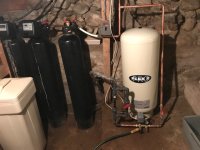rScotty
Super Member
- Joined
- Apr 21, 2001
- Messages
- 9,586
- Location
- Rural mountains - Colorado
- Tractor
- Kubota M59, JD530, JD310SG. Restoring Yanmar YM165D
Some background info that I didn't know before installing our own house water supply from a shallow well.
1. The biggest concern is pathogens.... i.e. bad bugs. Municipal water sourced from places like shallow ground water wells, creeks, rivers, & some springs kill the bugs with either a drip chlorine system, a biologically active sand filter (where good bugs eat bad ones) or by using Ultra Violet light.
Deep wells don't always need to kill pathogens. Deep wells are considered to be naturally free from contamination with pathogens as long as sterilization procedures are followed when the well is drilled and the pump is hung.
In most areas you can get your water tested for pathogens for a nominal fee.
2. Second concern is dissolved chemicals. This is the largest concern with deep well water. Metals range from arsenic to lead to iron or uranium. Chemicals are things like fluorine & carbonates. There will always be some amount of everything, so the health services have limits to all of these. Since they are dissolved, filters will not remove them. If you care about this, you may want to do what we do, which is to send a water sample to local state university every few years and they send back an analysis which also notes if any of these dissolved chemicals are over or under the limits. Costs a hundred bucks or so...
3. The last concern is the only thing that filters will remove. i.e. particles that make muddy water. This is way down on the list of things to worry about. The number of particles is counted in a measurement called the "turbidity index" that measures how transparent or muddy the water is. Particles are not much of a danger themselves. They are only a concern because pathogens can hide behind these particles and avoid the chlorine or UV sterilization.
BTW, you can get transparent filter housings at Home Depot. All of mine came from there and have lasted 20 years now.
enjoy, rScotty
1. The biggest concern is pathogens.... i.e. bad bugs. Municipal water sourced from places like shallow ground water wells, creeks, rivers, & some springs kill the bugs with either a drip chlorine system, a biologically active sand filter (where good bugs eat bad ones) or by using Ultra Violet light.
Deep wells don't always need to kill pathogens. Deep wells are considered to be naturally free from contamination with pathogens as long as sterilization procedures are followed when the well is drilled and the pump is hung.
In most areas you can get your water tested for pathogens for a nominal fee.
2. Second concern is dissolved chemicals. This is the largest concern with deep well water. Metals range from arsenic to lead to iron or uranium. Chemicals are things like fluorine & carbonates. There will always be some amount of everything, so the health services have limits to all of these. Since they are dissolved, filters will not remove them. If you care about this, you may want to do what we do, which is to send a water sample to local state university every few years and they send back an analysis which also notes if any of these dissolved chemicals are over or under the limits. Costs a hundred bucks or so...
3. The last concern is the only thing that filters will remove. i.e. particles that make muddy water. This is way down on the list of things to worry about. The number of particles is counted in a measurement called the "turbidity index" that measures how transparent or muddy the water is. Particles are not much of a danger themselves. They are only a concern because pathogens can hide behind these particles and avoid the chlorine or UV sterilization.
BTW, you can get transparent filter housings at Home Depot. All of mine came from there and have lasted 20 years now.
enjoy, rScotty

